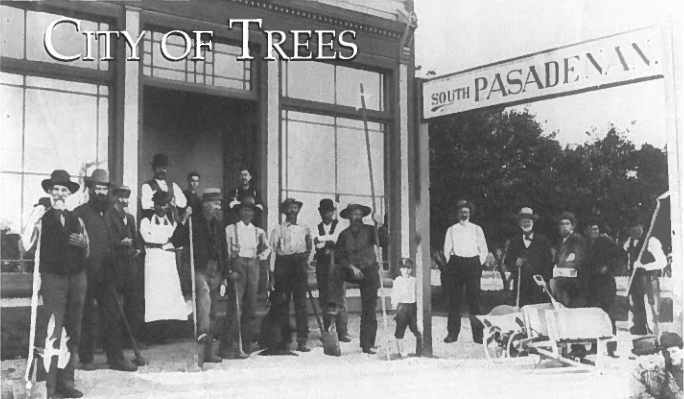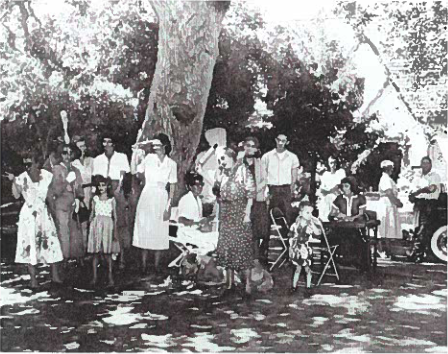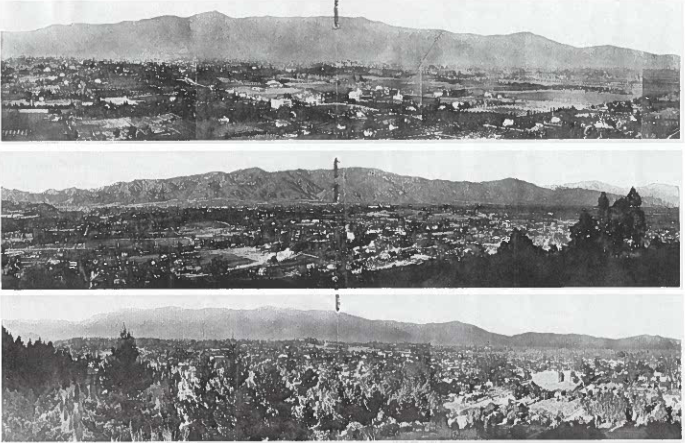The Story of South Pasadena's Tree Heritage
By Rick Thomas
The Quarterly Magazine, Spring 2017

South Pasadena is a small city. Truth be told, it's more like a town in many ways than a "real city." Our residents support the police and fire departments, public library, and schools – one of the best public school districts in the San Gabriel Valley.
But what makes this place truly special are its people. The sun brought us here and kept us planted. Speaking of planting, one story I'd like to share with you began over one hundred years ago. And it has given South Pasadena its most enduring heritage.
The First Tree Planting
Around 125 years ago, the only trees that covered our fledgling city were citrus groves. The first visitors spent their winters at the valley's first resort hotel, The Raymond. Then came the land boom of the late 1880s, causing property values to skyrocket. The local orange groves gave way to neighborhoods, streets, and home sites. Thus, South Pasadena's rich heritage as the "City of Trees" was about to be born.
On April 24, 1894, our town folk gathered out front of the newspaper office, The South Pasadenan. The men arrived with shovels and picks. They planted 1,000 shade trees in a single day. The trees were donated by Horatio Nelson Rust from his family-run Rust Nursery in town. Members of the Woman's Improvement Association also gathered to clean up the area around the Santa Fe depot (near South Pasadena's Gold Line Station today). The local paper noted, "the women with their own hands planted trees and made a park."
The First Fighters

Before city residents were known as freeway fighters, they earned their chops fighting the city to protect its trees. On August 18, 1950, South Pasadena citizens made national headlines when they created a human blockade on Edgewood Drive to save a 200-year-old oak tree from removal by the city. They gained support from around the country when they defied the city shouting, "Do not take this tree!", carrying brooms and armed with rolling pins. They would not budge until the city agreed to spare the precious oak.
Tree Nazis
If you were a fan of the Jerry Seinfeld Show in the 1990s, you are familiar with the recurring character "Soup Nazi": A fussy cook with the best soup in the city and a well-deserved reputation for remaining true to his ruthless vision of what soup should be and how his patrons must behave. O.K., so he pissed people off, but his customers always came back.
South Pasadena's Natural Resources commissioners are the "Tree Nazis" of our city. I should know, I once served on the commission. The most important duty as commissioner was saving our trees and enhancing the city's "urban forest." We regularly listened to requests for tree removal by homeowners and developers, like the couple who wanted to cut down their palm tree because the parrots screeched loudly in the palm leaves. We all felt sorry for the sleepless people, especially because the palm's crown was at window-level of their master bedroom. We booted that one to the city's Animal Commission.
A ridiculous request I remember was a homeowner who asked permission to remove a jacaranda tree because it obscured their balcony view of the annual fireworks show at the high school sports field. She even brought her children to our meeting as witnesses. It didn't matter, we always listened patiently, and ended up saying "no." If the tree was healthy, it lived to see another day.
We denied request after request, even if the homeowner offered to pay the city for the cost of planting additional trees elsewhere. One homeowner offered to pay expenses for planting five trees – any type, anywhere in the city – in exchange for permission to remove the one massive sycamore tree that clearly was too big for his home lot. It hung over his roof like The Leaning Tower of Pizza. We denied his request, of course. Then he offered ten trees. Our answer was the same.
There was only one tree we ever gave our blessing to remove. A nursery which specializes in mature rare trees, said it was worth 25,000 and offered to remove it without charge. They promised it would be well cared for: placed into their private stock to be planted at a later date on a commercial site where such trees are treasured.
The City's Urban Forest

In 1922, the Security Pacific Bank published a booklet about the history of South Pasadena that was given to bank members. A two-page spread of three panoramic views of South Pasadena taken from Monterey Hills showed the dramatic tree growth over a span of nearly 30 years from 1895 to 1922. The bottom caption reads: "The growth of trees has been so great as to almost obscure the fact the whole valley is now filled with homes."
From the city's water tower on Monterey Hills today, there is only one house completely visible in the foreground. A variety of trees is seen, including palm, elm, oak, eucalyptus, magnolia, pepper, cypress, jacaranda, and pine. The two major streets of Fremont and Fair Oaks are only identifiable because of two large towers sticking up through the tree canopy: The Holy Family Church (Fremont Avenue) and South Pasadena Middle School (Fair Oaks Avenue). The neighborhood surrounding the middle school is shrouded in a dense tree-scape known as the city's "urban forest."
A Unique and Unifying Experience
Whether it's the magnificent mature palms on Stratford Avenue, the Morton Fig at Library Park, or the jungle-like tree cover and screeching parrots on Diamond Avenue, neighborhoods acquire their own unique character from the trees that line their streets.
South Pasadena's love of trees is also a unifying experience that can be enjoyed by motorists and pedestrians alike. Residents call it "purple rain" when the jacaranda blossoms fall like rain covering the street, front yards, cars, and people as they walk along the sidewalks on Marengo Avenue. During the height of the jacaranda tree blossoms, motorists say it feels like they are traveling through a purple tunnel.
In South Pasadena, we believe that our love of trees brings us together. We are a small-town family of tree huggers. The city's Tree Policy is like our religion.